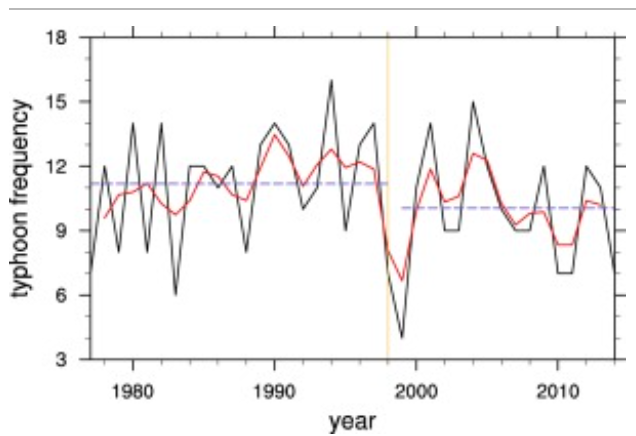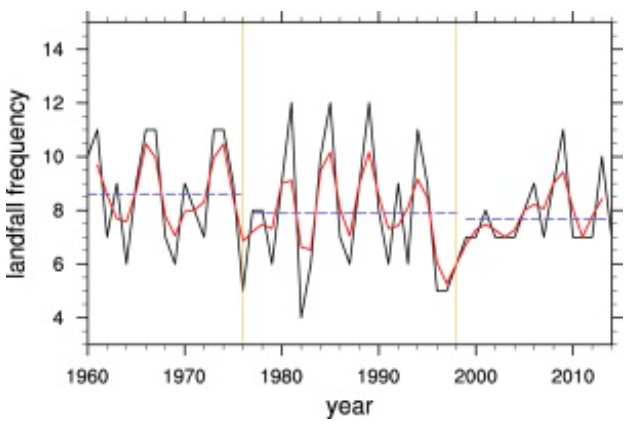A new paper authored by Hu et al appearing in the journal Dynamics of Atmospheres and Oceans finds that tropical cyclone (TC) genesis frequency in the western North Pacific (WNP) during 1960–2014 shows a step-by-step decrease and is linked to natural oceanic cycles, namely to the phase of the Interdecadal Pacific Oscillation (IPO).
Hat-tip: Mary Brown
Sea surface temperature “cannot explain”
The authors found that vertical wind shear especially the zonal wind shear plays a critical role, while other parameters such as sea surface temperature (SST), vertical velocity, divergence, humidity and maximum potential intensity cannot explain the step-by-step decrease of tropical cyclone genesis frequency.
A further diagnosis shows that the interdecadal change of vertical wind shear is caused by sea surface temperature and associated rainfall pattern changes across the Indo-Pacific Ocean.
A stronger warming in the Indian Ocean/western Pacific from 1960–1976 to 1977–1998 led to enhanced convection over the Maritime Continent and thus strengthened vertical shear over the key tropical cyclone genesis region in the WNP.
A La Nina-like sea surface temperature pattern change from 1977–1998 to 1999–2014 led to a strengthened Walker circulation in the tropical Pacific, which further enhanced the vertical shear and decreased tropical cyclone genesis frequency in the WNP.
No consensus
In the paper’s introduction the authors write that elements behind the changes in western North Pacific tropical cyclone activity is a hotly debated topic and that the objective of the current study was to investigate tropical cyclone activity change in the recent years and the cause of it.
The authors have shown that the phase of the Interdecadal Pacific Oscillation (IPO) had two obvious shifts since 1960 (Hartmann and Wendler, 2005, Lyon et al., 2013). One happened around 1976/77 and the other around 1998/99.
The authors plotted the evolution of total typhoon (with maximum wind speed exceeding 32.7m/s) frequencies in the WNP since 1977 and TC landfalls on China since 1960 (see the paper’s Fig. 9, Fig. 10; below).
Total number of typhoons during June-October from 1977 to 2014 in the WNP (black line). The red line represents interdecadal variation with an 8-year low-pass filter. The purple dashed line is the average of the red line in two periods based on the IPO phase shifts as divided by the vertical orange lines. Source: Hu et al 2018
Total number of TC landfalls on China during June-October from 1960 to 2014 (black line). The red line represents interdecadal variation with an 8-year low-pass filter. The purple dashed line is the average of the red line in three periods based on the IPO phase shifts as divided by the vertical orange lines. Source: Hu et al 2018
The authors say that it is interesting to note that the typhoon frequency decreases significantly from ID2 (1977–1998; Typhoon number is 11) to ID3 (1999–2014; Typhoon number is 10).
As for the TC landfalls on China, the average numbers for the three periods are 8.6, 7.8 and 7.6 respectively. The decrease from ID1 to ID2 is statistically significant, passing a 95% confidence level, while the decrease from ID2 to ID3 is not significant.







Don’t you love “settled science”?😉
[…] Read more at No Tricks Zone […]
[…] https://notrickszone.com/2018/10/21/scientists-find-western-pacific-cyclone-genesis-has-decreased-sin… […]